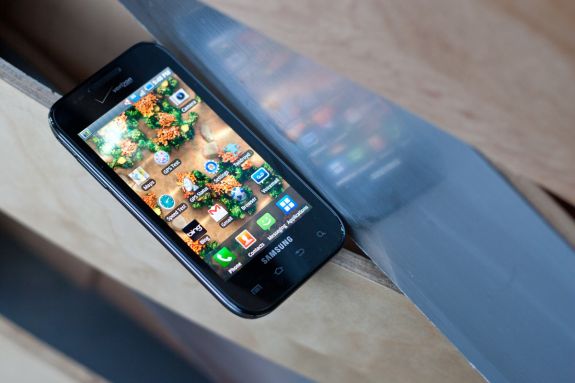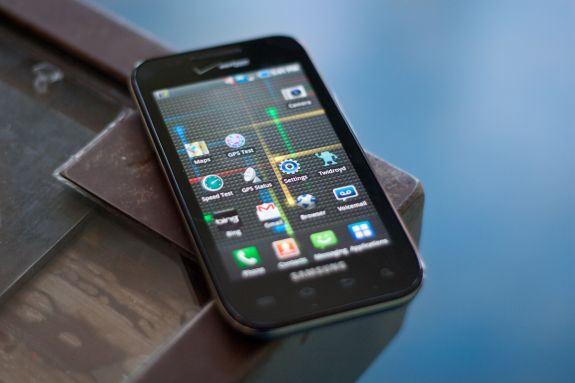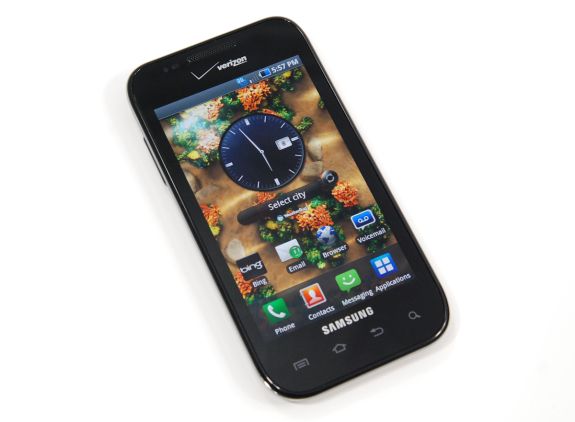Samsung Fascinate Review: Verizon's Galaxy S Smartphone
by Brian Klug on October 5, 2010 12:01 AM EST- Posted in
- Smartphones
- Samsung
- Galaxy S
- Fascinate
- Mobile
Final Thoughts
The Fascinate ultimately leaves me with two completely conflicting final conclusions.
On one hand, the hardware and platform itself is undeniably the best out there - Hummingbird and the SGX 540 make the whole experience incredibly fluid in places where it counts. There's absolutely no doubt about how snappy and smooth Android feels throughout, even on 2.1. The 1 GHz Hummingbird just does an awesome job. Everyone I've let play with the Fascinate says the same thing, it feels fast and fluid. Fire up that default gallery application and compare with a Nexus One and you'll see exactly what I'm talking about.
The screen is also undeniably among the best on the Android platform, given a run for its proverbial money only by the Droid and Droid 2's IPS panels. There's less glare compared to the non-super AMOLED variety we've seen in the Nexus One outside, and it's measurably brighter as well, all thanks to fewer air-glass interfaces and those pesky fresnel reflection coefficients adding up.
There camera is nicely done, including 720P video recording and a suite of customizations for camera control. Oh, and you've also got an LED flash - something the Captivate and Vibrant lack.
Battery life needs work, but it's on par with the original Motorola Droid in every area except call time.
The rest of the experience is a bit more sordid, however. There's that glaringly blatant GPS issue that the entire Galaxy S line never should have shipped with, but what really sticks out in my mind is what Verizon has done to the software side. It's hard to even tell you're on a Google phone given how much Bing there is on the device, and just about everywhere else it's possible is something Verizon branded.
For power users, this admittedly isn't a big deal. Root the thing and change it, install a custom ROM, and be done with it. To some extent, Android is the new Windows Mobile because of just how much you can change and customize, and how both enjoy strong and active ROM cooking communities. For normal users however, this is just this same kind of platform-confusion which led to Windows Mobile's eventual identity crisis and death. Every device came with different software, different carrier customizations, and different experiences. Getting that out of box install light is what makes high end smartphones feel more like smartphones and less like chintzy featurephones.
The rest of the weird, out of place Bing facsimiles of Google apps can thankfully be remedied by a quick trip to the applications marketplace. The unfortunate part is that you'll never really be rid of them since you can't uninstall them without rooting.
Then there are just completely disingenuous things like making the default search engine Bing, and not allowing users to change it or delete preinstalled carrier bookmarks - again without rooting. Android is open, sure, it's a question of just who it's open to.
Ultimately, the Fascinate is up against the HTC Incredible, Motorola Droid 2 and Droid X on Verizon. It's better than the Incredible for sure so let's just kick that out of the running. The Droid 2 has a physical keyboard which the Fascinate does not, so if you need physical keys you have your answer. Which leaves us with the Droid X. Motorola gives you better battery life, a better GPS experience and the freedom to be given Google Maps and Search from the start. Samsung on the other hand gives you a smaller form factor, a faster SoC and a punchier display. If you're on the road a lot, use GPS, and need the most out of each charge, pick the Droid X. If you don't mind Droid 1 battery life and a flaky GPS which will hopefully be fixed quickly, go for the Fascinate.
Wait another 6 - 8 months, and you'll probably have something even better than both of these to choose from.













73 Comments
View All Comments
Ethaniel - Tuesday, October 5, 2010 - link
Good thing you directly recommend rooting and flashing the device. That Verizon-pseudo Google-Bing combo is kinda creepy... and bloated.medi01 - Tuesday, October 5, 2010 - link
"Outside readability in practice is improved from the Nexus One. "Dare I ask whether it is improved from, God forbid, iPhone 4? :rolleyes:
deputc26 - Tuesday, October 5, 2010 - link
In the performance page,Loading Engadget Times
EVO Should be 2.2 not 2.1.
Brian Klug - Tuesday, October 5, 2010 - link
I haven't included numbers from the EVO running 2.2 yet, although I've got them and will do so, those are current for 2.1 (as marked) ;)-Brian
Shlong - Tuesday, October 5, 2010 - link
it seems the Epic with Sprint is the best out of the Galaxy S line.alovell83 - Tuesday, October 5, 2010 - link
The Korean Galaxy S would beg to differ. FF cam + DMB. Yes, you do lose out on 4G, but you save hundreds on the life of the contract and it isn't as much up front either. Out of those available to the U.S. it's the $10 4G tax, without necessarily receiving a 4G signal which is the bummer, but you still get the best kit subsidized state-side. Living in a 4G city, the Epic is a no-brainer. Outside, we are talking about $300 more, assuming you don't get an amazon $.01 deal which would bump the contract life of the Epic to more than $400 more than the others...just for a FF camera and (cross you fingers, hopefully) to one day get a 4G signal in your city is just asking for too much.silverblue - Tuesday, October 5, 2010 - link
I have the UK version of the Galaxy S, and it's quite odd how many variants are out there. Differences on the UK version:1) no LED flash
2) sports an FF cam
3) the micro-SD slot is on the left inside the back, with the SIM card to the right and the built-in micro-SD above that
4) the buttons are confined to Menu on the left, Back on the right, and a physical Home key in the middle
5) the headphone socket has a black plastic surround instead of chrome effect (strangely, the review states 18mm - shouldn't that be 35mm?)
6) there's a "with Google™" logo on the back along with the SAMSUNG logo but no mention of Galaxy S; there's no mention of the carrier.
7) the phone weighs less at 118g
8) The default wallpaper isn't a Live one
deputc26 - Tuesday, October 5, 2010 - link
Interesting and yes that should be 35mmBrian Klug - Tuesday, October 5, 2010 - link
Yeah, I meant 3.5mm, 1/8 inches. Fixed ;)-Brian
chemist1 - Tuesday, October 5, 2010 - link
The single most important function of a phone is to, well, be a phone, i.e., do voice communication. And one of the characteristics most important to voice communication is the audio quality---both sending and receiving (via the earpiece or a headset; the percent of time spent listening via speakerphone is, for most, is less than for the earpiece or a headset). Yet, in a very long and otherwise thorough review, I could find only one sentence that addressed earpiece audio quality:"Earpiece performance and volume is adequate - voice quality is as good on the Fascinate as I've seen on other CDMA handsets in the testing I performed."
And I could find no mention of audio quality from the headset jack, nor any mention of audio quality for someone on the receiving end of a call from this phone.
It's sort of like reading a detailed review of a new camera, in which lots of attention is given to metering, focus, etc. (all parameters that affect image quality), but with only a single sentence on how good the images are after metering, focus, etc. is dialed in. Likewise, you have several paragraphs on issues that affect audio quality -- e.g., the dependence of signal attenuation on how the phone is held-- but again, only one sentence on how good the phone actually sounds (and nothing on how good I sound to someone I'm calling) after these secondary effects are taken care of. I.e., suppose I'm receiving a call under ideal conditions (say, it's from a land line, there's a strong signal, I am holding the phone optimally, etc.). In that case, do you mean to tell me that someone with a trained ear would hear no difference in audio quality when listening through the earpieces of different CDMA handsets? While this may be true, I certainly would not be convinced of that based on reading just your one sentence, since it does not give the impression that a serious attempt to assess audio quality has been made.
As you can likely tell, I'd like to strongly suggest that, in future reviews, the comparative audio quality of these phones is addressed in a more serious and discriminating manner, by someone with extensive audio expertise and a highly trained ear. The reason your site is so well-respected is because it brings an unusual level of sophistication to computer hardware reviews. I’d like to see that same sophistication applied to audio performance, when you are reviewing devices where audio performance should be central (phones and portable music players).
I've been following this site for many years, and I think you folks are the best --- you do a fantastic job. But your expertise is computers, it's not audio. And often, when you venture into audio, I don't see it approached it with the level of sophistication with which you approach computer hardware. You can see your site's extraordinary sophistication with computer hardware with, for instance, Anand's perspicacious reviews of SSDs, in which he identified 4K random read and write speeds (as opposed to sequential large-block performance) as being the key to real-world performance. Yet, by contrast, when Anand was reviewing the audio perfomance of the iPod Nano, he just cookbooked the standard set of Rightmark Audio Analyzer measurements (http://www.anandtech.com/show/3903/apples-ipod-tou... he didn't demonstrate the audio expertise to first listen, and then make an informed decision of which measurements needed to be done. If he had, he might have realized that problems lie in areas that would only be revealed by a different set of measurements. Anand then went on to say "I believe we've hit a ceiling for PMP audio playback quality." Well, no, it could still be improved quite a bit. It is informative to contrast how Anand approached audio with, for instance, Marc Heijligers' astute analysis of iPod audio performance, at: http://homepage.mac.com/marc.heijligers/audio/ipod...
[I did mention this in the comments for Anand’s review, but it was towards the end of the thread, so they may not have been noticed.]
I suspect that, if you want the audio component of your reviews to be up to the high level of sophistication you show for computer hardware, you're going to need to bring in someone with years of audio expertise and a highly trained ear.
Thanks for listening to this very long comment!